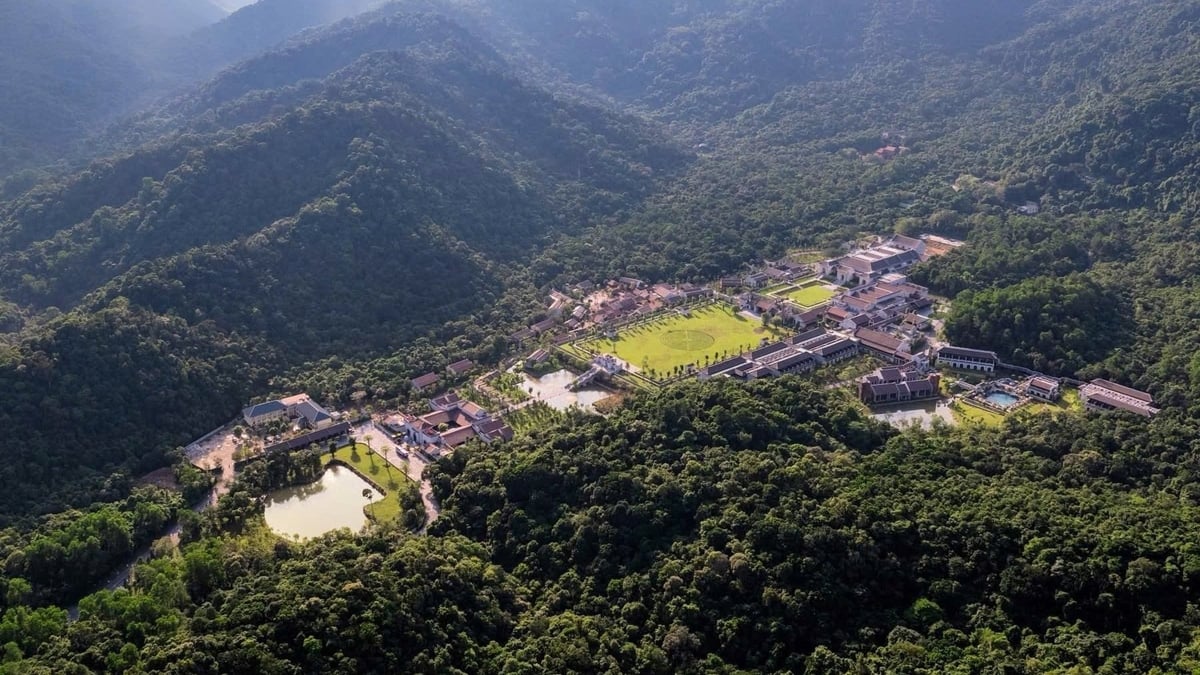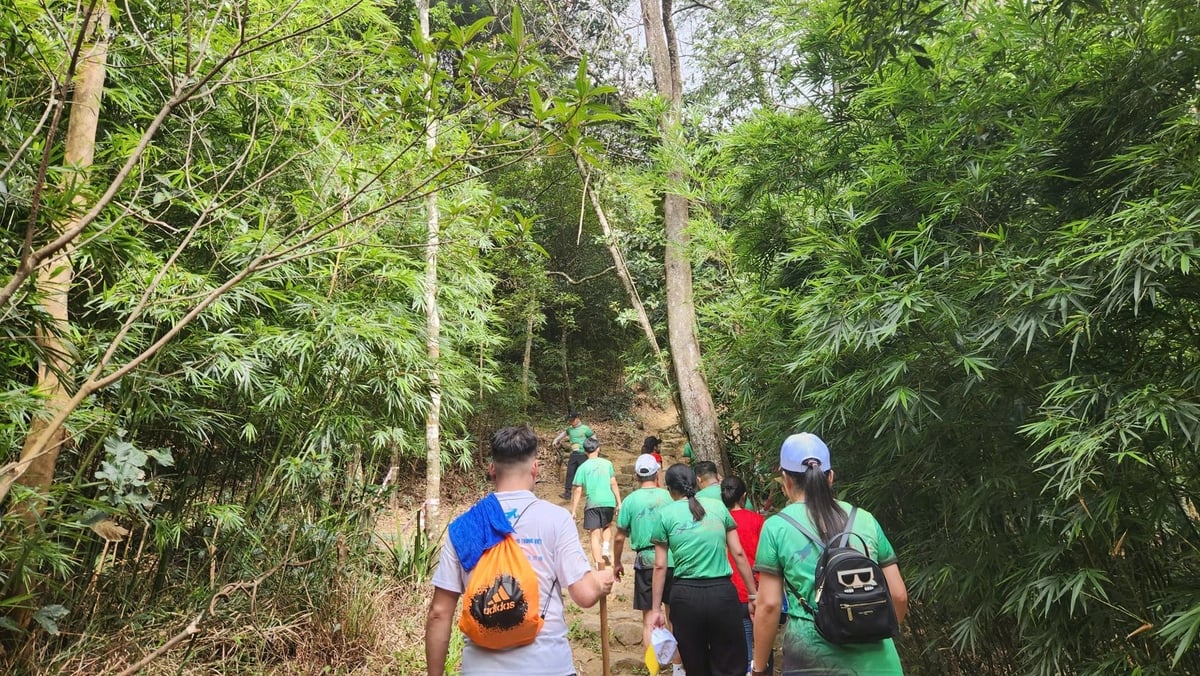December 5, 2025 | 02:04 GMT +7
December 5, 2025 | 02:04 GMT +7
Hotline: 0913.378.918
December 5, 2025 | 02:04 GMT +7
Hotline: 0913.378.918
Prime Minister Pham Minh Chinh attended the ceremony proclaiming the Outstanding Universal Value of the Yen Tu – Vinh Nghiem – Con Son, Kiep Bac World Cultural Heritage Site in the solemn and majestic setting of the Truc Lam Cultural Center (Yen Tu) on the evening of August 17, 2025. This is the ninth world heritage site in Vietnam and the second trans-provincial heritage site, following the Ha Long Bay – Cat Ba Archipelago.

The ceremony featured a unique musical performance that emphasized the global significance of the Yen Tu – Vinh Nghiem – Con Son, Kiep Bac World Cultural Heritage Site. Photo: Nguyen Thanh.
The complex is not only the origin of the Truc Lam Zen sect, an elite spiritual tradition founded by King-Monk Tran Nhan Tong, but also a living embodiment of the harmony between nature, faith, and nation. The heritage is characterized by grandeur, simplicity, and purity, as evidenced by its mountain scenery, pilgrimages, and ancient architecture from various dynasties.
In the days following UNESCO's recognition, international media praised Yen Tu as "a leading global invitation to pilgrimage, meditation, and spiritual tourism." From a professional perspective, UNESCO emphasized that heritage is not merely a remnant of the past but a living source that can influence the future by combining conservation efforts with economic opportunities for communities.
Yen Tu has already proven its strong appeal in Vietnam by offering well-planned infrastructure and experiences such as Sunrise at Dong Pagoda, Journey Following King-Monk Tran Nhan Tong's Footsteps, and the Yen Tu Autumn Festival, which have attracted millions of domestic and foreign visitors. This is not merely a sightseeing excursion for many; rather, it is a profound cultural and spiritual voyage, particularly for international tourists who are interested in engaging with Vietnamese culture and people.
However, the land, forests, and cultural identity must not be sacrificed to win the hearts of visitors. Ha Long Bay, where its natural marvels were once threatened by pollution, coastal encroachment, and uncontrolled exploitation, continues to serve as a valuable lesson for Vietnam. UNESCO even dispatched experts to evaluate the hazards in Ha Long due to urbanization and a wealth of services.

Nearly 3,000 hectares of forest, including plenty uncommon plant species, are situated in Yen Tu. Photo: Nguyen Thanh.
The Yen Tu National Forest, which spans a total natural area of 2,783 hectares, is considered a living museum that preserves the diverse ecosystems of Vietnam's special-use forests. Five plant divisions and 830 species, 670 of which are angiosperms, comprise its flora, which is exceedingly diverse in terms of genera, families, and species. Of these, 38 are endemic and uncommon species.
The plant life in this region is distinguished by its comprehensive array of life forms, with phanerophytes (above-ground bud plants) occupying the majority, comprising 84.29% of the species. Large and medium-sized timber trees are the most prevalent species within this group.
The flora of Yen Tu is also abundant in resources, with 547 beneficial species that fall into 13 application categories. About 300 of these plants are medicinal, including highly valuable species like Panax vietnamensis, Anoectochilus setaceus, and Schefflera heptaphylla.
The Zen communities and Buddhist followers' devotion, as well as King Tran Nhan Tong's monastic life, are clearly associated with several centuries-old trees. In 2016, Yen Tu National Forest identified 144 trees that met heritage criteria. These trees include one purple banyan, one Diospyros decandra, 102 Podocarpus fleuryi (red pine), 10 vast resin pines, 21 endemic Yen Tu Ochna integerrima, and nine ancient Michelia champaca. These heritage trees are exceptional for their longevity, which spans from 300 to over 700 years, in addition to their cultural and spiritual significance.

Visitors are able to fully experience the pristine nature of Yen Tu. Photo: Nguyen Thanh.
The fauna is similarly diverse, with 151 terrestrial vertebrate species. Twenty of these species, including the Tonkin snub-nosed monkey, giant flying squirrel, Leptobrachium ailaonicum, Quasipaa spinosa, and Shinisaurus crocodilurus, are included in Vietnam's Red Book. These species are of significant importance in the fields of genetic conservation, scientific research, education, and tourism.
With these distinctive characteristics in mind, Yen Tu exercise caution, for visitors seeking reflection and serenity, its nature and primeval forests must remain the soul of the experience. UNESCO continually stands for sustainable tourism strategies that prioritize the involvement of local communities and align conservation with development. Research has emphasized the necessity of incorporating local guides into heritage management frameworks to regulate visitor flows, safeguard landscapes, and preserve culture. This is due to the fact that they possess the most practical knowledge of tourist behavior and Heritage values.
The Prime Minister identified five key tasks in response to the dual demand for development and conservation: the establishment of a comprehensive legal framework, the clarification of management responsibilities, the integration of conservation with risk management, the promotion of heritage, and the advancement of sustainable tourism. The goal is to transform every citizen into a cultural ambassador.
Yen Tu has the potential to become a premier destination for cultural experiences, ecotourism, and spiritual tourism. However, to achieve sustainability, it must exhibit the fortitude and sincerity of a monk, who are characterized by their calm, selective, gentle, and genuine nature. Community, biodiversity, and sacred identity comprise the four pillars of Yen Tu's shining future.
Yen Tu is no longer merely Vietnam's narrative; it is a symphony of global integration, spirituality, and nature. Conservation remains the primary means of preserving its identity despite the fact that international tourism is expanding its reach. When the past is honored and nature is preserved, visitors will come not only with their eyes but also with their emotions.
Yen Tu is home to 20 uncommon plant species that have been documented in Vietnam's Red Book. Of these, six necessitate priority conservation and development. Erythrophleum fordii, Sindora tonkinensis, Madhuca pasquieri, Vatica odorata, Podocarpus fleuryi, Piper lolot, and Bruguiera gymnorrhiza are representative species. The forest vegetation of the region is divided into two primary types: tropical evergreen closed forest and subtropical low-mountain evergreen closed forest.
Translated by Linh Linh

(VAN) As of 2025, the ASEAN region has a total of 69 ASEAN Heritage Parks recognized across its 10 member states. Among them, Viet Nam contributes 15 ASEAN Heritage Parks.

(VAN) Yok Don National Park has high biodiversity with numerous endemic plant and animal species, and it is also the only dipterocarp forest ecosystem conservation area in Viet Nam.

(VAN) Viet Nam and Brunei signed two important MOUs on fisheries and IUU, expanding cooperation in agriculture, the environment, and Halal exports, aiming to substantively implement joint projects.

(VAN) The Viet Nam Coconut Association worked with the International Finance Corporation (IFC) and businesses to promote the supply chain, enhance competitiveness, and develop the coconut industry sustainably.
![Hue aims for Net Zero: [2] Pioneering low-emission tourism](https://t.ex-cdn.com/nongnghiepmoitruong.vn/608w/files/huytd/2025/12/04/0633-dulichzero-4-095634_236-161125.jpg)
(VAN) The ancient capital of Hue has developed Net Zero tourism products and models, aiming to reduce carbon emissions and pioneer the establishment of Viet Nam's green tourism destination.

(VAN) C.P. Viet Nam has announced the successful completion of its goal to plant 1.5 million trees during the 2021-2025 period, a key milestone within company's long-term ESG strategy and its roadmap for emission reduction.

(VAN) This is an initiative of MAE aimed at creating a unified coordination mechanism to implement agricultural cooperation programs with developing countries.